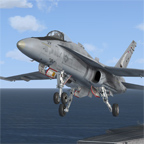
Flight Notes—how to fly the Boeing F/A-18 Hornet
The F/A-18A Hornet fighter/attack aircraft entered service with the U.S. Navy and Marine Corps in 1980. This fast, maneuverable twin-engine single-seater has been flown by the Navy Blue Angels demonstration team since 1986. Deliveries of the upgraded F/A-18C began in 1989, and F/A-18As were upgraded with the new plane's engines and other systems.
The Hornet combines the ruggedness required of carrier-borne aircraft with speed and superior agility, especially at high angles of attack. Its powerful engines, canted vertical stabilizers, horizontal stabilators, large leading- and trailing-edge flaps, and sophisticated flight control system all contribute to a level of performance that makes the Hornet a versatile front-line fighter in several air forces around the world.
Carrier Operations
| Function | Key Command |
| Tail Hook (Extend/Retract) | SHIFT+Q |
| Takeoff Assist (Arm/Disarm) | SHIFT+I |
| Launch Bar (Extend/Retract) | SHIFT+U |
| Takeoff Assist (Trigger) | SHIFT+SPACEBAR |
Specifications
| U.S. | Metric | |
| Maximum Speed (high altitude) | 1.8 Mach | 1.8 Mach |
| Maximum Speed (low altitude) | 720 knots | 1,333 km/hr |
| Cruise Speed | 580 knots | 1,074 km/hr |
| Engine | 2 General Electric F404-GE-402, low bypass turbine, 6-stage afterburners | |
| Empty Weight | 24,500 pounds | 11,113 kilograms |
| Takeoff Gross Weight (clean) | 37,000 pounds | 16,783 kilograms |
| Length | 56 feet | 17 meters |
| Wingspan | 37.4 feet | 11.4 meters |
| Height | 15.1 feet | 4.6 meters |
| Seating | 1 | |